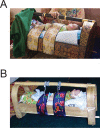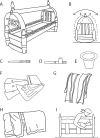The ties that bind: Cradling in Tajikistan
- PMID: 30379916
- PMCID: PMC6209138
- DOI: 10.1371/journal.pone.0204428
The ties that bind: Cradling in Tajikistan
Abstract
A traditional childrearing practice-"gahvora" cradling-in Tajikistan and other parts of Central Asia purportedly restricts movement of infants' body and limbs. However, the practice has been documented only informally in anecdotal reports. Thus, this study had two research questions: (1) To what extent are infants' movements restricted in the gahvora? (2) How is time in the gahvora distributed over a 24-hour day in infants from 1-24 months of age? To answer these questions, we video-recorded 146 mothers cradling their infants and interviewed them using 24-hour time diaries to determine the distribution of time infants spent in the gahvora within a day and across age. Infants' movements were indeed severely restricted. Although mothers showed striking uniformity in how they restricted infants' movements, they showed large individual differences in amount and distribution of daily use. Machine learning algorithms yielded three patterns of use: day and nighttime cradling, mostly nighttime cradling, and mostly daytime cradling, suggesting multiple functions of the cradling practice. Across age, time in the gahvora decreased, yet 20% of 12- to 24-month-olds spent more than 15 hours bound in the gahvora. We discuss the challenges and benefits of cultural research, and how the discovery of new phenomena may defy Western assumptions about childrearing and development. Future work will determine whether the extent and timing of restriction impacts infants' physical and psychological development.
Conflict of interest statement
The authors have declared that no competing interests exist.
Figures





Similar articles
-
Gahvora cradling in Tajikistan: Cultural practices and associations with motor development.Child Dev. 2023 Jul-Aug;94(4):1049-1067. doi: 10.1111/cdev.13919. Epub 2023 Apr 4. Child Dev. 2023. PMID: 37016553 Free PMC article.
-
Object play in Tajikistan: Infants engage with objects despite bounds on play.Infancy. 2025 Jan-Feb;30(1):e12627. doi: 10.1111/infa.12627. Epub 2024 Sep 28. Infancy. 2025. PMID: 39340802
-
Comparison of U.S. and Tajik infants' time in containment devices.Infant Child Dev. 2022 Jul-Aug;31(4):e2340. doi: 10.1002/icd.2340. Epub 2022 May 27. Infant Child Dev. 2022. PMID: 36329695 Free PMC article.
-
Onset and evolution of stunting in infants and children. Examples from the Human Nutrition Collaborative Research Support Program. Kenya and Egypt studies.Eur J Clin Nutr. 1994 Feb;48 Suppl 1:S90-102. Eur J Clin Nutr. 1994. PMID: 8005095 Review.
-
Handedness as a major determinant of lateral bias in human functional cradling.Infancy. 2024 Mar-Apr;29(2):84-94. doi: 10.1111/infa.12572. Epub 2023 Dec 15. Infancy. 2024. PMID: 38100601 Review.
Cited by
-
The mountain stream of infant development.Infancy. 2023 May;28(3):468-491. doi: 10.1111/infa.12538. Epub 2023 Mar 24. Infancy. 2023. PMID: 36961322 Free PMC article.
-
Real-Time Assembly of Coordination Patterns in Human Infants.Curr Biol. 2020 Dec 7;30(23):4553-4562.e4. doi: 10.1016/j.cub.2020.08.073. Epub 2020 Sep 24. Curr Biol. 2020. PMID: 32976812 Free PMC article.
-
Parental Perspectives and Infant Motor Development: An Integrated Ecological Model.Children (Basel). 2025 May 31;12(6):724. doi: 10.3390/children12060724. Children (Basel). 2025. PMID: 40564682 Free PMC article. Review.
-
Social dynamics of supported walking in 11-month-old infants.Infant Behav Dev. 2024 Dec;77:101994. doi: 10.1016/j.infbeh.2024.101994. Epub 2024 Oct 3. Infant Behav Dev. 2024. PMID: 39366138
-
Developing language in a developing body, revisited: The cascading effects of motor development on the acquisition of language.Wiley Interdiscip Rev Cogn Sci. 2022 Nov;13(6):e1626. doi: 10.1002/wcs.1626. Epub 2022 Sep 27. Wiley Interdiscip Rev Cogn Sci. 2022. PMID: 36165333 Free PMC article. Review.
References
-
- Save the Children. (2011). Harmful traditional practices in Tajikistan. Retrieved from http://www.ohchr.org/Documents/HRBodies/CEDAW/HarmfulPractices/SavetheCh...
-
- Adolph K. E., Karasik L. B., & Tamis-LeMonda C. S. (2010). Motor skills In Bornstein M. H. (Ed.), Handbook of cultural development science. Vol. 1. Domains of development across cultures (pp. 61–88). New York, NY: Taylor and Francis.
-
- Chisholm J. S. (1978). Swaddling, cradleboards, and the development of children. Early Human Development, 2, 255–275. - PubMed
-
- Tronick E. Z., Morelli G. A., & Winn S. (1987). Multiple caretaking of Efe (Pygmy) infants. American Anthropologist, 89, 96–106.
-
- van Sleuwen B. E., Engelberts A. C., Boere-Boonekamp M. M., Kuis W., Schulpen T. W. J., & L'Hoir M. P. (2007). Swaddling: A systematic review. Pediatrics, 120, 1097–1106. - PubMed
Publication types
MeSH terms
Grants and funding
LinkOut - more resources
Full Text Sources

